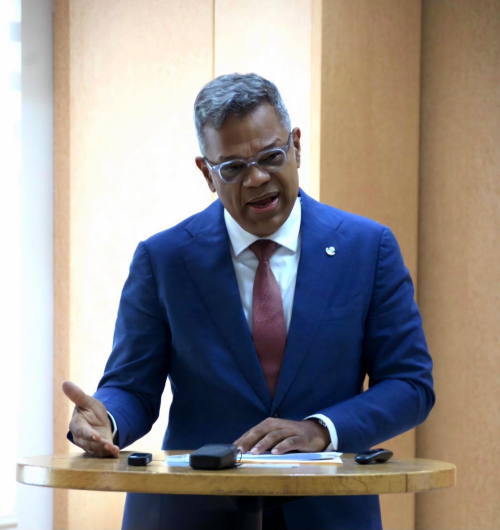 PHILIPSBURG:--- The Ministry of Public Health, Social Development and Labor (VSA) is pleased to announce the official launch of the IVSA Strengthening Project, which kicked off last week. This initiative marks a step toward enhancing the capacity and effectiveness of the Inspectorate of Health, Social Development, and Labor (IVSA).
PHILIPSBURG:--- The Ministry of Public Health, Social Development and Labor (VSA) is pleased to announce the official launch of the IVSA Strengthening Project, which kicked off last week. This initiative marks a step toward enhancing the capacity and effectiveness of the Inspectorate of Health, Social Development, and Labor (IVSA).
Earlier this year, the TWO approved the IVSA project as part of Sint Maarten’s broader institutional strengthening agenda under the Country Package. The project focuses on modernizing IVSA’s organizational structure, clarifying roles and responsibilities, and ensuring its operations are supported by a coherent legislative framework.
The first phase of the project, approved by the Council of Ministers (CoM), establishes the project team:
•
Mrs. Jorien Wuite – Project Manager
•
Mrs. Noella Ruivenkamp – Organizational Developer
•
Mr. Jan Egbert Temmink – Legislative Draftsman
The team will work closely with the Ministry’s leadership and staff to assess the Inspectorate’s current functions and develop proposals aimed at strengthening oversight, compliance, and service delivery in public health, social development, and labor.
Minister of VSA, Richinel Brug, welcomed the initiative, stating: "Strengthening the IVSA is essential to ensuring that the Ministry can continue to effectively safeguard the health, safety, and well-being of our community. This project represents an important step toward a more modern and responsive."
Regular updates on the progress of the IVSA Strengthening Project will be shared as implementation advances.
Navy ship HNLMS Pelikaan delivers emergency aid to Jamaica again.
 JAMAICA:--- After successfully delivering its first load of relief supplies, HNLMS Pelikaan is once again en route to Jamaica to deliver emergency aid.
JAMAICA:--- After successfully delivering its first load of relief supplies, HNLMS Pelikaan is once again en route to Jamaica to deliver emergency aid.
Immediately after delivering relief supplies and emergency materials to Jamaica on Tuesday, November 4th, the ship departed for Barbados that same day with a new load of supplies. Last Saturday, the ship was loaded with relief supplies and emergency materials for the second time. The Dutch navy ship will arrive in Jamaica later today, Wednesday, November 12th.
HNLMS Pelikaan again carries essential relief goods, including vehicles, emergency tents, and medical supplies. The containers on board are filled with over 150,000 cans of food and other basic necessities such as solar-powered lamps, jerrycans, and generators. During its previous delivery of relief supplies to Jamaica, the ship transported, among other items, a desalination unit for producing drinking water, 1,440 emergency rations, 1,000 shelter kits, 1,200 emergency tents, and 1,400 field beds.
HNLMS Pelikaan is equipped with a crane and a large cargo hold. This makes the logistical support ship ideally suited for the relief task. Providing assistance is one of the Defense Department's three main tasks in the Caribbean Region.
Ocean Literacy at Its Best: Eco Detectives Curacao wins the Big Live Nature Quiz as Participation Hits New High.
 Kralendijk, Bonaire:--- The Dutch Caribbean Nature Alliance (DCNA) is thrilled to announce the results of the 2025 Big Live Nature Quiz – Kids Edition! This edition has reached an all-time high number of registrations. Schools from all over the Dutch Caribbean signed up for the region’s biggest educational ocean literacy event!
Kralendijk, Bonaire:--- The Dutch Caribbean Nature Alliance (DCNA) is thrilled to announce the results of the 2025 Big Live Nature Quiz – Kids Edition! This edition has reached an all-time high number of registrations. Schools from all over the Dutch Caribbean signed up for the region’s biggest educational ocean literacy event!
The quiz theme changes every year, focusing on different key conservation topics across the six Dutch Caribbean islands. This year’s theme, “Marine Habitats,” covered all the different marine habitats found on our islands and their important ecosystem services. From our shorelines to the deep ocean, primary students once again showcased their knowledge and passion for nature.
2025 Big Live Nature Quiz
Over 850 students from across the six Dutch Caribbean islands participated in this 5th edition of the Big Live Nature Quiz. This outreach event can be considered a growing success, bringing together more primary schools and young nature enthusiasts each year from Aruba, Bonaire, Curaçao, Saba, St. Eustatius, and St. Maarten to test their knowledge, learn, and have fun along the way!
The Champions
The winning team of this year’s quiz is “Eco Detectives Curacao” from Curaçao American Preparatory School! With impressive knowledge of coral reefs, seagrass meadows, lagoons, bays, and their important role as nursery areas, they outshone their competitors to claim first place in the 2025 Big Live Nature Quiz. As a well-deserved reward for their outstanding performance, the team will enjoy an exciting sailing and snorkeling trip with their teacher, giving them the chance to explore the marine life around their island and deepen their practical knowledge about marine habitats. Time to get hands-on, orshould we say,or goggles on!
Fun local prizes also await the local winner of each island, recognizing their passion, knowledge, and commitment to marine habitats. The local winners are:
● Aruba: Tortuga (St. Annaschool)
● Bonaire: Sea Lions (IKC Kristu Bon Wardador)
● Curaçao: Eco Detectives Curacao (Curacao American Preparatory School)
● Saba: Intelligent girls (Sacred Heart School)
● St. Eustatius: Blue Beads (Governor de Graaff School)
● St. Maarten: The Science Children St. Maarten (Asha Stevens Hillside Christian School)
These teams, who showcased outstanding knowledge and teamwork, will each be awarded Big Live Nature Quiz rashguards to further inspire their love for the ocean and its ecosystems.
Prime Minister Mercelina pushes for action on plastic ban.
PHILIPSBURG:--- Prime Minister Dr. Luc Mercelina reaffirmed his government’s commitment to environmental reform and fair labor practices during the Council of Ministers press briefing. The Prime Minister discussed the plastic ban legislation, immigration management, and protection of migrant workers, emphasizing the need for both sustainability and social fairness.
Plastic Ban Legislation Moving Forward
Responding to a media question, Prime Minister Mercelina confirmed that legislation banning single-use plastic bags and other plastic materials is advancing through the government’s legislative process.
“The document is still at the Department of Legal Affairs (AZ), and we are now trying to accelerate the process to make sure that we get it executed,” Mercelina said.
“I think it’s high time for us to have a Plastic-Free St. Martin.”
The proposed legislation—drafted initially with input from Plastic Free SXM and submitted in December 2024—seeks to align St. Martin with global environmental standards by curbing plastic pollution across businesses and households.
Prime Minister Mercelina Congratulates People of Sint Maarten on Unity and Successful St. Martin Day Celebration.
 PHILIPSBURG:--- Prime Minister Dr. Luc Mercelina opened Wednesday’s Council of Ministers press briefing by extending warm congratulations to the people of Sint Maarten on the successful celebration of St. Maarten Day, held on November 11, 2025.
PHILIPSBURG:--- Prime Minister Dr. Luc Mercelina opened Wednesday’s Council of Ministers press briefing by extending warm congratulations to the people of Sint Maarten on the successful celebration of St. Maarten Day, held on November 11, 2025.
“Once more, I would like to congratulate the people of Sint Maarten on this very important national day,” the Prime Minister said. “Yesterday demonstrated our unity as a country. We need that unity to confront the future and its challenges.”
Dr. Mercelina praised the spirit of collaboration and mutual respect displayed during the festivities, noting that St. Maarten Day continues to symbolize solidarity between the southern Dutch side and northern French side of the island.
“The people of Sint Maarten showed once more that they are a people of unity, and especially unity with our northern neighbours on the French side,” he said. “We look forward to continuing to live in a peaceful country in unity.”
Unity as the Foundation for National Progress
The Prime Minister underscored that national unity remains central to his government’s vision for progress and resilience. He reminded citizens that the challenges ahead — from economic recovery to social development — require continued cooperation across communities and political lines.
“A day like yesterday once more demonstrates our unity. And we need our unity to confront the future with its challenges,” he said.
Dr. Mercelina ended his remarks by expressing pride in the people of Sint Maarten for their commitment to harmony and progress, adding that unity remains the strongest foundation for the country’s continued growth.